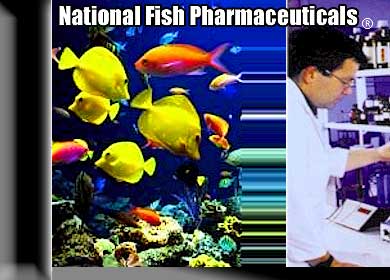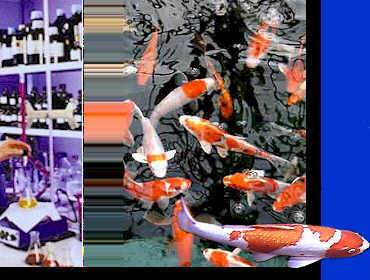|
|
Koi Pond Water Quality |
|
Chlorine and Chloramines Chlorine and chloramines are
harmful to fish and will kill the beneficial nitrifying bacteria in
the pond. Likewise, they may burn or kill aquatic plants.
Chlorine, a volatile gas, will dissipate with water circulation and
exposure to the air within one or two days. Chloramines,
however take much longer to break down. City water suppliers
are more frequently adding ammonia to combine with chlorine to
product the longer-lasting chloramines. It is not uncommon for
city water to test positive for ammonia straight out of the tap.
When adding chlorinated water to the pond, spray it in with a
hose to provide the necessary aeration for dissipation of the gas.
Sodium Thiosulfate will remove chlorine from water and also pull
chlorine from the chloramines. A stock solution of four ounces
of Sodium Thioslufate crystals to one gallon of distilled water
makes your stock solution. One drop per gallon (50ml per 1,000
gallons) with safely de-chlorinate your pond. Make sure to use
a test kit to monitor your ammonia levels carefully. High
ammonia levels cause disease, and death.
As a precautionary measure, if the pool is regularly topped off
or changed 5 to 10 percent weekly with chlorinated water, setting up
fultration through one pound of zeolite per 100 gallons of
pond water will help to remove residual ammonia. |
 |
Heavy MetalsWell water may contain ferrous
bicarbonate, detected by a brown precipitate that forms when neutral
or alkaline water is aerated. Besides being mildly irritating
to the fish, ferrous bicarbonate stains equipment and causes water
to become cloudy.
E.D.T.A. (Ethylene Diamine Tetra Acidic Acid) can be used to
chelate out any heavy metals such as iron or copper from the water.
To make a stock solution with EDTA, use 1 teaspoon and mix it with 4
ounces of distilled water. Shake well. Then use 2 drops
of this stock solution per gallon of pond water. EDTA will
lower your pH, so care should be used when adding it to the pond.
We suggest taking a pail of water out of the pond, check the pH and
then add 2 drops of EDTA per gallon of pail water. Mix the
water well and then test the pH once again. The maximum amount
per day that the pH may be dropped is 0.2, any more can pH shock the
fish, make the fish stressed and cause a disease outbreak in the
pond. |
|
Contaminated WaterRun-off water from a nearby stream,
or collected rainwater may contain toxic insecticides, herbicides or
fertilizers. Rainwater from metal roofs or asbestos shingles
will contaminate the pond and may prove toxic to both the fish, and
the plants. If the fish display signs of toxicity, execute a
50% water change and/or remove the fish to safe quarters, or a
hospital tank until the water has been changed.
Acid rain may produce stress in water lilies. Immediately
following to a heavy rainfall, the lily leaves may show signs of
burning at the edges or abrupt yellowing. A partial water
change may be needed after such rainy periods, if the pH readings
are lower than the neutral 7.0 range.
White foam at the waterfall entry of the pond is a sign of a high
level of dissolved organic compounds. Do some partial water
changes and add some Aqua Gold to the pond to handle the high
organic load. |
|
Water pH The pH range of 6 to 8.5 is acceptable for most
pond life. The primary concern with pH is its direct
relationship to the toxicity of ammonia and nitrite. Each pH
interger above the neutral 7 reflects a tenfold increase in such
toxicities.
Any pH value below the neutral 7 is considered acidic.
Baking soda or ground limestone will raise the pH level.
pH values over 8.5 will definitely stress the fish to the point
of disease. We receive some calls where the pond owner claims
to have a pH reading of 9.0 or more, and the cause for this is
cement or mortar leeching toxic lime into the water. Bricks
or untreated mortar blocks used as plant pedestals, run-off water,
and reconstituted materials used in or around the pond may be
washing in leeched lime which can cause severely high pH readings.
We suggest you use a commercial lime neutralizer or a nontoxic
pool sealant paint if you have a concrete pond.
If the pH is normally high in your tap water, we suggest
obtaining more suitable fish for your pond, such as the common
goldfish, shubunkin, or comet goldfish. These fish can
tolerate higher (non-toxic) pH levels.
|
|
Adding Salt To Your Pond Salt is pretty amazing in it's
ability to control algae, detoxify Nitrites, kill parasites and it's
antiseptic qualities. Salt is a great item to use for your
water quality, but first... you need to know how much to add.
We feel that a 0.1% continual salt bath is a good level to run at
all the time. To achieve this level, add 1¼
ounces of salt per 10 gallons of pond water.
The maximum level of salt that you can run
without major damage to the fish is 0.3%. This high salt level
is used for treating fish wounds and parasites. To achieve
this level, add 3.8 oz. of salt per 10 gallons. This salt
level is better suited for a bath, or in a hospital tank.
Never ever take your main pond up to a level like this. Long
term exposure to high salt content will damage or kill the fish and
your biological filter. This salt level should be used for a
15 minute bath only.
|
|
Home
ı
Articles ı
Prevention ı
Fish
Diseases ı
About Us ı
Contact Us ı
Terms of Use ı
Privacy Policy ı
Shipping ı
Products |
|

